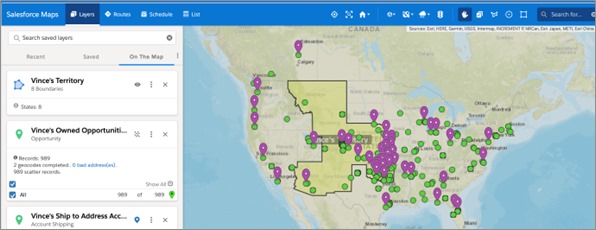Salesforce maps for real estate management is a robust feature designed to provide a geographical context for your data. While commonly utilized for sales territory management, field service scheduling, and event planning, its versatility extends to real estate management. In this blog post, we delve into how Salesforce Maps proves invaluable in efficiently managing clients and properties. Furthermore, we’ll explore examples showcasing how real estate professionals leverage Salesforce Maps a powerful tool for real estate management to gain insights and make informed decisions. Learn more about salesforce maps for real estate management
How Salesforce Maps Works
Salesforce Maps a powerful tool for real estate management operates as a cloud-based mapping platform seamlessly integrated with your Salesforce data. Its flexibility allows you to create and customize maps using diverse data types, including customers, sales, locations, or custom objects. The addition of layers facilitates the organization and visualization of data in various ways.
For instance, you can generate a map displaying all properties on the market, color-coded by price range. Layers can be added to showcase income levels and bank presence in specific areas, aiding in identifying potential buyers. The ability to filter maps based on criteria such as property type, status, or size enhances data refinement.
Spatial analysis capabilities are a standout feature, enabling tasks like finding nearest or farthest locations, calculating drive times or distances, and creating trade areas or territories. These functionalities contribute to optimizing routes, planning visits, and resource allocation. Salesforce Maps for real estate management offers the convenience of accessing and updating data from any location using any device. Whether viewing maps on desktops, tablets, or mobile phones, real-time synchronization with Salesforce ensures seamless collaboration. Sharing maps with team members or clients is effortless through email, Chatter, or reports.
How Salesforce Maps Can Help You with Real Estate Management
salesforce maps for real estate management proves beneficial across various facets of real estate management:
-
- Finding and qualifying leads: Utilize Salesforce Maps for real estate management to identify potential clients based on location, demographics, preferences, or behavior. Qualify leads by assessing their proximity to properties, budget, or readiness to buy or sell.
-
- Managing and marketing properties: Effectively handle property inventory, track status and performance, and target the right audience for marketing. Compare properties based on features, location, or price with ease.
-
- Providing excellent customer service: Enhance customer service with personalized and timely interactions. Schedule appointments, send notifications, and showcase relevant properties on a map to address client needs effectively.
-
- Analyzing and optimizing your business: Leverage Salesforce Maps for real estate management for data analysis, gaining insights into sales performance, identifying trends, and evaluating marketing campaigns. Optimize processes, reduce costs, and increase efficiency based on informed decisions.
Examples of How Real Estate Agents and Managers Are Using Salesforce Maps
Explore real-world scenarios illustrating the application of Salesforce Maps for real estate management:
-
- A real estate agent identifies potential leads by creating a map showcasing homeowners who have lived in their homes for more than a decade. Filtering by income level and property value, she targets likely sellers, reaching out via email or phone to offer services.
- A real estate manager effectively manages his property portfolio by creating a map categorizing properties by status. Additional layers depicting average days on the market and sales prices aid in adjusting pricing strategies and marketing plans.
- A real estate agent enhances customer service by creating a map displaying properties matching a client’s criteria. Layers indicating nearby amenities and attractions are added, enriching the client’s decision-making process.
- A real estate manager analyzes business performance by creating a map showcasing sales transactions over the past year. Layers displaying market share and growth rates for each area inform strategic planning for future goals.
Conclusion
In conclusion, Salesforce Maps for real estate management emerges as a powerful tool for real estate management, offering capabilities to find and qualify leads, manage and market properties, provide excellent customer service, and analyze and optimize business operations. Incorporating Salesforce Maps for real estate management provides a competitive edge in the dynamic real estate market, facilitating business growth. We hope you enjoyed this blog post and found it useful. If you have any questions or feedback, please let us know in the comments below. Thank you for reading.

